Search results for: 'den'
-
 Published Roman fibula with celtic design
Published Roman fibula with celtic designAncient fibula from the Roman province of Britain. The design can be attributed to the celtic tribe of the Trinovantes or Iceni. From the famous Hattatt collection. Published twice.
Price: on request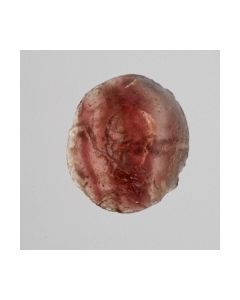 Roman intaglio with Eros as a child
Roman intaglio with Eros as a childThe god of love known from Greek Mythology is engraved in a beautiful violet glass.
Price: on request Römischer Fingerhut
Römischer FingerhutKörper an Öffnung zusammengedrückt, einige kleine Löcher im Metall, ansonsten guter Erhaltungszustand.
Price: on request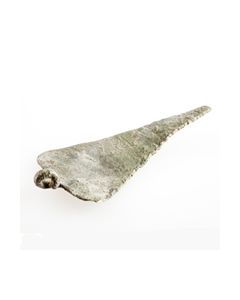 Römisches Amulett aus Bronze, Vulva
Römisches Amulett aus Bronze, VulvaÄltestes apotropäisches Symbol der Menschheitsgeschichte. Schlichte Ausführung, ungewöhnliches Exemplar.
Price: on request Schön geformte skythische Pfeilspitze
Schön geformte skythische Pfeilspitzeantike Bronzepfeilspitze. Dreiflüglig. Exzellente Erhaltung mit schöner Patina. Typisch für skythische Völker ab ca. 700 v.Chr.
Price: on request Sehr schöne skythische Pfeilspitze
Sehr schöne skythische Pfeilspitzeantike Bronzepfeilspitze. Dreiflüglig, sehr gute Erhaltung mit Patina. Typisch für Skythische Völker ab ca. 700 v.Chr.
Price: on request Roman intaglio with Hermes
Roman intaglio with HermesThe engraved glass dates back to the Roman Republic. It shows the Greek god of the travel and trade. He is holding a purse and cloak in his hands.
Price: on request Egyptian New Year flask with ornamentation
Egyptian New Year flask with ornamentationHieroglyphic inscription expressing New Year wishes for Ptah at the beginning of the nile floodings. Important 26th dynasty piece associated with the Egyptian New Year rituals. The object is a fantastic example of the skilled workmanship and artistic quality of faience in ancient Egypt.
Price: on request Scarab with breath of life
Scarab with breath of lifeThe Ankh on the bottom side of this ancient egyptian scarab symbolized life or afterlife. The symbol is framed by volutes.
Price: on request Egyptian Scarab
Egyptian ScarabThe Egyptian scarab has a central cross on the stamp side. The piece dates to the 21st dynasty of Ancient Egypt. It is described in the catalogue of Gautier-Vodoz.
Price: on request Großer, römischer Spinnwirtel
Großer, römischer SpinnwirtelSpinnwirtel aus Ton. Kegelförmig, Durchmesser 49 mm. Aus römsicher Zeit.
Price: on request Eindrucksvolle Terrakottafigur
Eindrucksvolle TerrakottafigurRömische Statuette einer aufrecht stehenden Venus. Mantel öffnend, um ihre Blöße zu enthüllen. Museale Erhaltung, sehr hohes Detailreichtum bis in die Mimik und Frisur. 1. - 3. Jh. n. Chr.
Price: on request Römisches Bleigewicht
Römisches BleigewichtBleigewicht in Scheibenform mit kleiner zentraler Bohrung. Durchmesser 21 mm, Gewicht 31.1 Gramm, ca. 1 und 1/4 Unze.
Price: on request Roman bronze Silen head
Roman bronze Silen headInteresting ancient part of large bronze jar. Very nicely preserved. Great patina.
Price: on request Skythische Pfeilspitzen aus Bronze
Skythische Pfeilspitzen aus Bronze2 antike Bronzepfeilspitzen. Dreiflüglig, gute Erhaltung. Typisch für Skythische Völker ab ca. 700 v.Chr. Aus dem danubischen Raum.
Price: on request Längliche römische Perle
Längliche römische PerleAntike Perle aus weißem Achat. 30mm lang, mit Längsbohrung.
Price: on request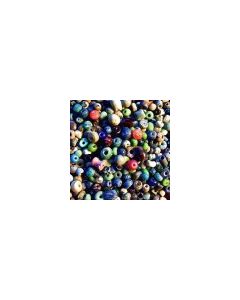 Perlen, assyrisch
Perlen, assyrischEtwa 800 v.Chr. bis 200 n.Chr. Damit vom Ende der dark ages bis in die Zeit römischer Herrschaft reichend. Fundort ist Syrien, einstiger Rand des assyrischen Reiches, später römische Provinz Syria.
Price: on request Ägyptisches Papyrusamulett
Ägyptisches PapyrusamulettPapyrusamulett aus mintgrüner Fayence, symbolisch für Jugend und Gedeien. Spätzeit des Alten Ägyptens, 664 bis 332 v. Chr.
Price: on request Protogeld in Form einer Pfeilspitze
Protogeld in Form einer PfeilspitzeVormünzliche Geldform aus dem 7. - 6. Jh. v. Chr., geprägt in Istros, perfekte Erhaltung. Länge 44 mm.
Price: on request Fragment einer römischen Platte mit Stempel LLIACVA
Fragment einer römischen Platte mit Stempel LLIACVAIn der uns vorliegenden Literatur nicht behandelt und ist damit möglicherweise selten. Es könnte sich auch um einen Legionsstempel handeln.
Price: on request Three Roman eye beads
Three Roman eye beadsGroup of beautiful miniature artworks made of mosaic glass. The beads are from early Roman Imperial times.
Price: on request Roman knee brooch
Roman knee broochPrime example of this important and popular type of brooch during the 2nd century.
Price: on request Protogeld in Form einer Pfeilspitze
Protogeld in Form einer PfeilspitzeVormünzliche Geldform aus dem 7. - 6. Jh. v. Chr., geprägt in Istros, guter Erhaltungszustand. Länge 32 mm.
Price: on request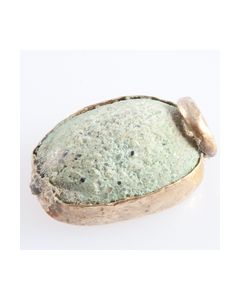 Kanaanitischer Skarabäus mit Goldfassung
Kanaanitischer Skarabäus mit GoldfassungSkarabäus-Amulett, mit massivem Goldband gefasst. Fundort: Israel, ca. 1700 v. Chr.
Price: on request Ägyptischer Uschebti mit rückseitigen Hieroglyphen
Ägyptischer Uschebti mit rückseitigen HieroglyphenÄgyptische Totenfigur. Rückseitige Hieroglyphen. Mintgrüne Fayence. Spätzeit bis Beginn ptolemäische Zeit, 664 v. Chr. bis 300 v. Chr.
Price: on request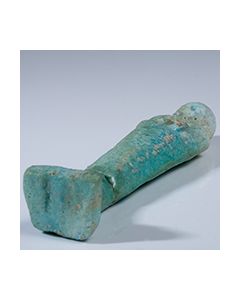 Ushebti aus der frühen Ptolomäerzeit
Ushebti aus der frühen PtolomäerzeitIntensiv-grüne Fayence, sehr großes Detailreichtum. Höhe ca. 95mm, 4. Jh. v. Chr., frühe ptolomäische Periode.
Price: on request Römisches Votivobjekt aus Blei
Römisches Votivobjekt aus BleiAntikes Votivobjekt aus Blei. Interessante Form, nicht näher bestimmte Darstellung. Aus alter deutscher Sammlung.
Price: on request Römisches Votivobjekt aus Blei
Römisches Votivobjekt aus BleiAntikes Votivobjekt aus Blei. Interessante Form, nicht näher bestimmte Darstellung. Aus alter deutscher Sammlung.
Price: on request Römisches Bleigewicht
Römisches BleigewichtBleigewicht in Tönnchenform, Höhe 17 mm, Gewicht 7.1 Gramm, ca. 1/4 einer Unze.
Price: on request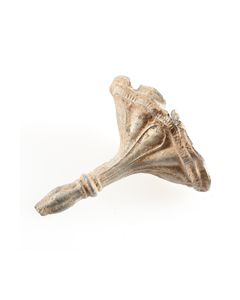 Römisches Votivobjekt aus Blei
Römisches Votivobjekt aus BleiAntikes Votivobjekt aus Blei. Interessante Form, nicht näher bestimmte Darstellung. Aus alter deutscher Sammlung.
Price: on request Roman bronze Minerva figurine
Roman bronze Minerva figurineNicely preserved example of Roman provincial art.
Price: on request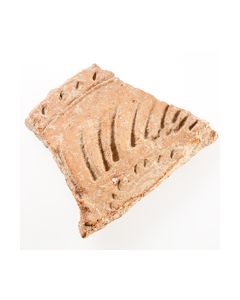 Keramikscherbe mit Dekor
Keramikscherbe mit DekorScherbe mit radialem Dekor in mehreren Registern. Vermutlich Teil einer dekorativen Keramikplakette oder Fliese. Aus deutscher Sammlung.
Price: on request Römisches Bleigewicht
Römisches BleigewichtBleigewicht in Tönnchenform, Länge 16 mm, Gewicht 12.9 Gramm, entspricht fast dem Gewicht einer halben Unze (13.55 Gramm), untergewichtig.
Price: on request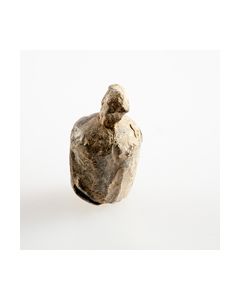 Römisches Bleigewicht
Römisches BleigewichtBleigewicht in Tönnchenform, Höhe 18 mm, Gewicht 11.6 Gramm. Ca. 10 scrupula bzw. 10/24 einer Unze.
Price: on request Römisches Bleigewicht
Römisches BleigewichtBleigewicht in Tönnchenform, Höhe 15 mm, Gewicht 6.9 Gramm, ca. 1/4 einer Unze.
Price: on request Römisches Bleigewicht
Römisches BleigewichtBleigewicht in Tönnchenform, Höhe 18 mm, Gewicht 9.7 Gramm, etwas mehr als ein Drittel einer Unze.
Price: on request

